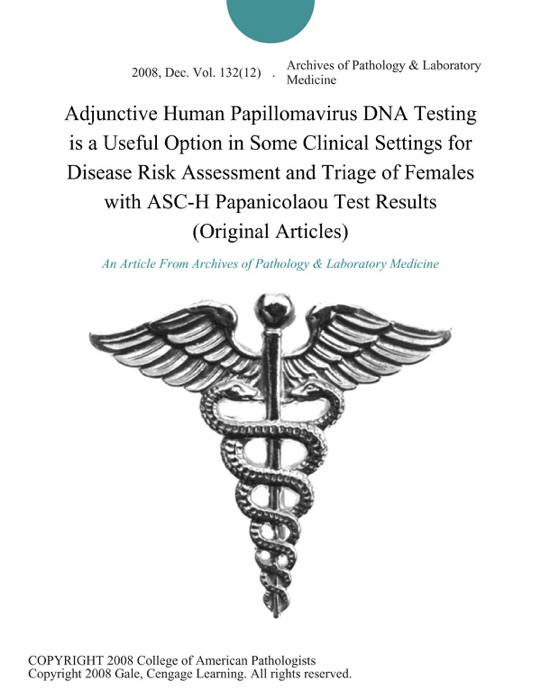[Download] ~ Adjunctive Human Papillomavirus DNA Testing is a Useful Option in Some Clinical Settings for Disease Risk Assessment and Triage of Females with ASC-H Papanicolaou Test Results (Original Articles) by Archives of Pathology & Laboratory Medicine ~ eBook PDF Kindle ePub Free

eBook details
- Title: Adjunctive Human Papillomavirus DNA Testing is a Useful Option in Some Clinical Settings for Disease Risk Assessment and Triage of Females with ASC-H Papanicolaou Test Results (Original Articles)
- Author : Archives of Pathology & Laboratory Medicine
- Release Date : January 01, 2008
- Genre: Health & Fitness,Books,Health, Mind & Body,
- Pages : * pages
- Size : 302 KB
Description
The abnormal Papanicolaou (Pap) test result category atypical squamous cells, cannot exclude high-grade squamous intraepithelial lesion (ASC-H), is a relatively recently recognized subcategory of atypical squamous cells (ASCs) formally introduced in the 2001 Bethesda System (TBS2001). (1) ASC-H Pap tests include a spectrum of abnormal cytomorphologic changes with features suggestive of a high-grade squamous intraepithelial lesion (HSIL) but judged to lack sufficient criteria for a definitive interpretation of HSIL. Therefore, ASC-H is often regarded as equivocal HSIL. (2) Inevitably included in the ASC-H category, however, are also benign mimics of high-grade dysplastic cells. This category reflects a mixture of true HSIL and its mimics. (3) ASC-H is a relatively uncommon Pap test interpretation and represents an interpretive challenge for both cytotechnologists and cytopathologists. The reported incidence of cases interpreted as ASC-H varies significantly among laboratories and has ranged from 0.22% to 1.09% of all Pap test results; the reported rate of subsequent histologic diagnoses of cervical intraepithelial neoplasia (CIN) 2/3 on follow-up tissue studies also varies widely and has ranged from 12.2% to 68.2%. (4-17) In addition, the reported rates of high-risk human papillomavirus (hrHPV) DNA detection in ASC-H cases also have ranged widely, from 33.3% to 85.6%. (2,4,5,7-11,14,18-34) Despite the reported variability in ASC-H reporting rates, histologic outcomes, and association with hrHPV DNA, Consensus Follow-up Guidelines from the American Society for Colposcopy and Cervical Pathology continue to suggest universal colposcopic referral to women with a Pap interpretation of ASC-H. (35,36) This recommendation was based primarily on data generated from the Atypical Squamous Cells of Undetermined Significance/ Low-Grade Squamous Intraepithelial Lesion (ASC-US/ LSIL) Triage Study (ALTS), in which ASC-H interpretations were rendered only on follow-up thin-layer cytology slides interpreted by a small group of 4 pathologists designated the Pathology Quality Control Group. (2) This group identified 110 ASC-H cases during internal quality control reviews and reported that 84% tested positive for hrHPV DNA.